Yannis Tsarouchis: Dancing in Real Life
TEXT BY JULIAN KROLL
ARTWORKS BY YANNIS TSAROUCHIS
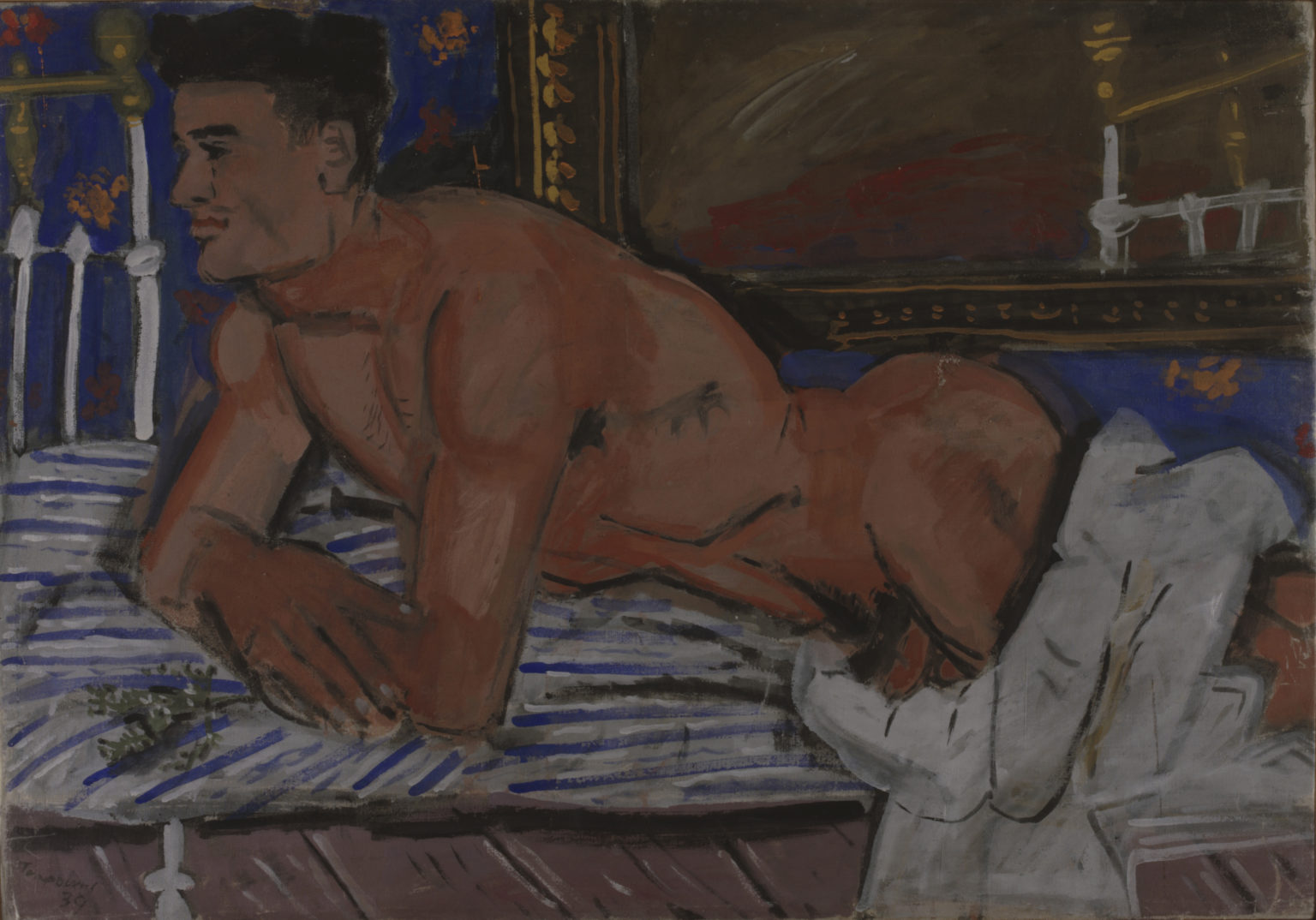
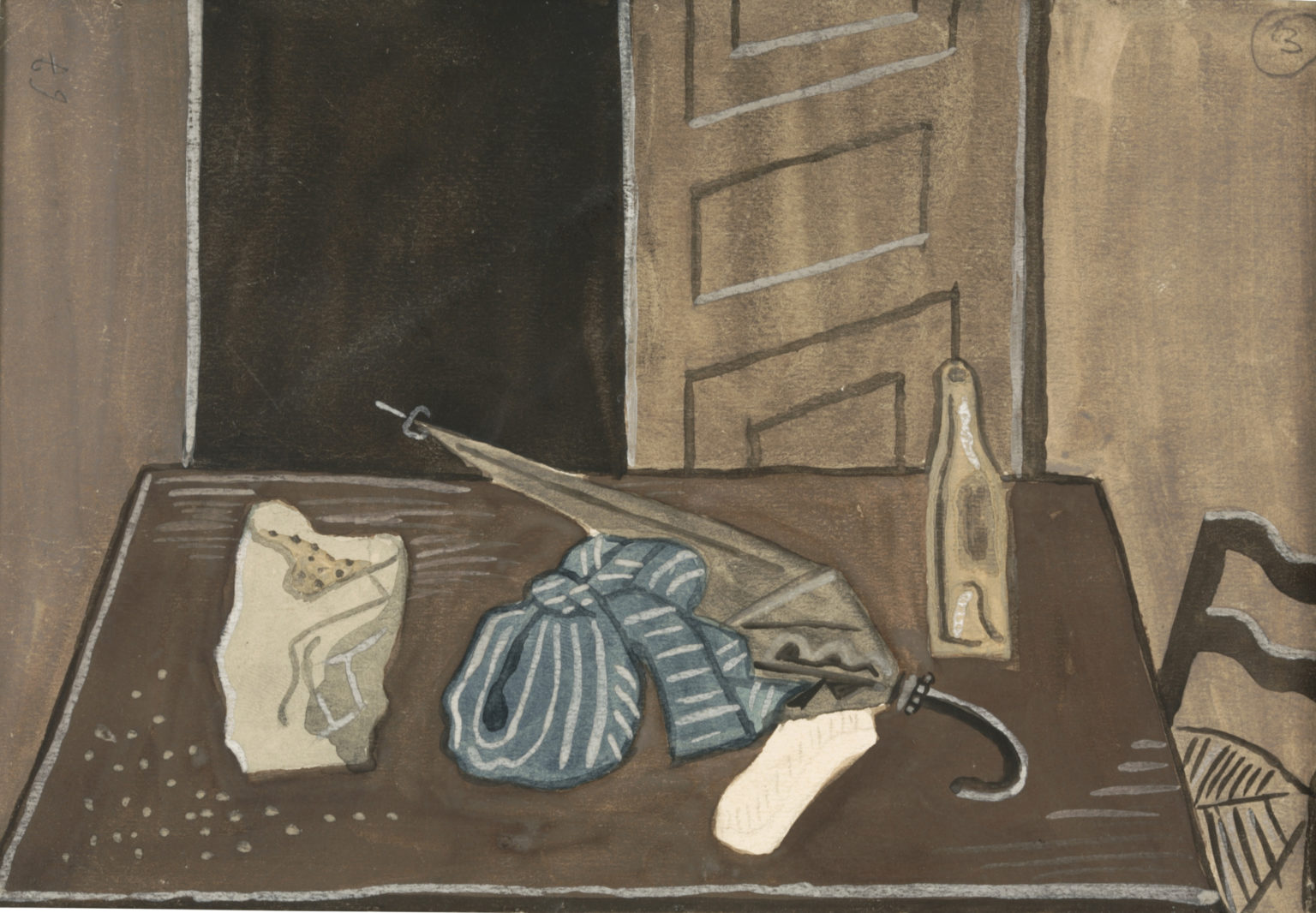


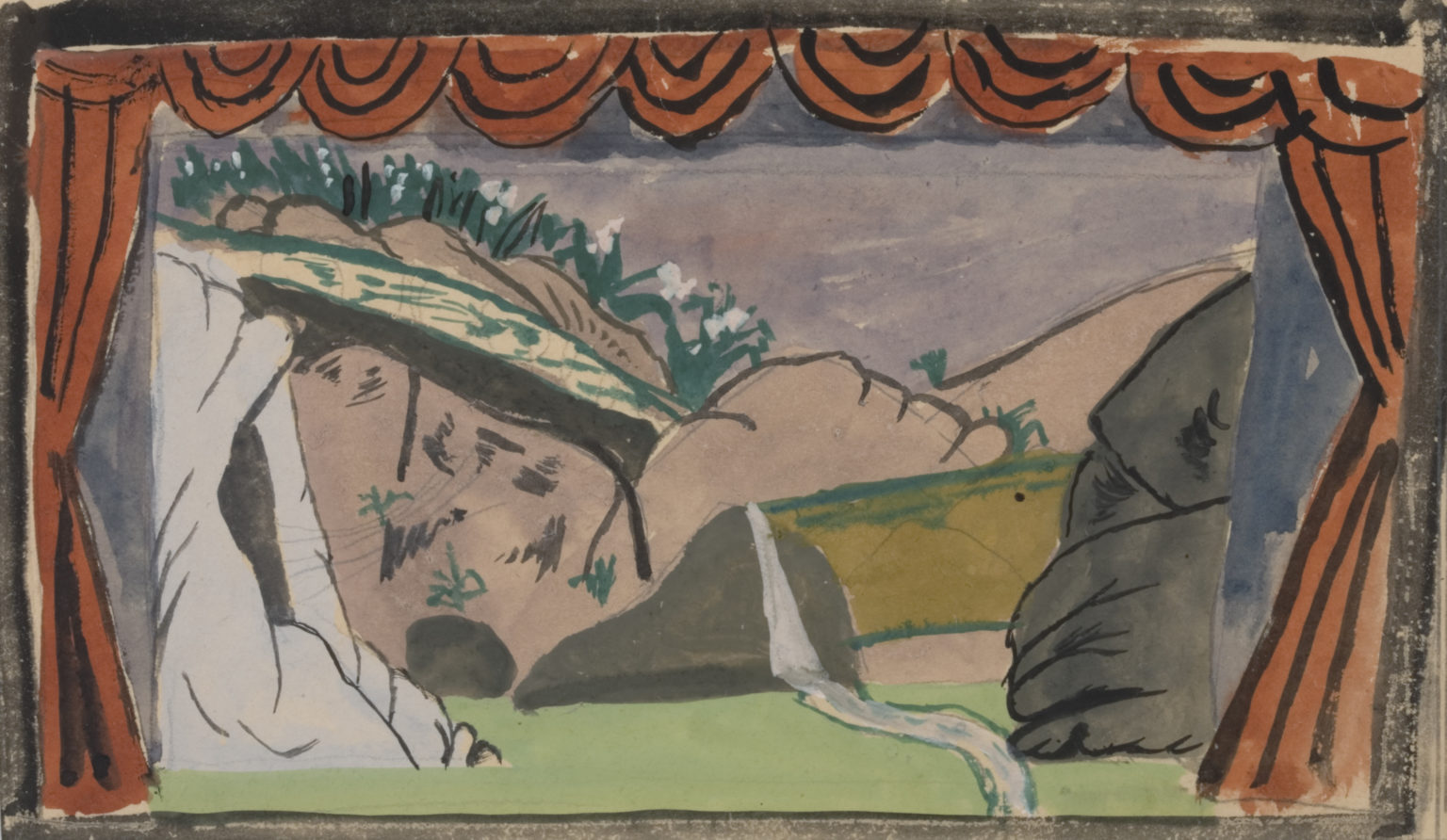

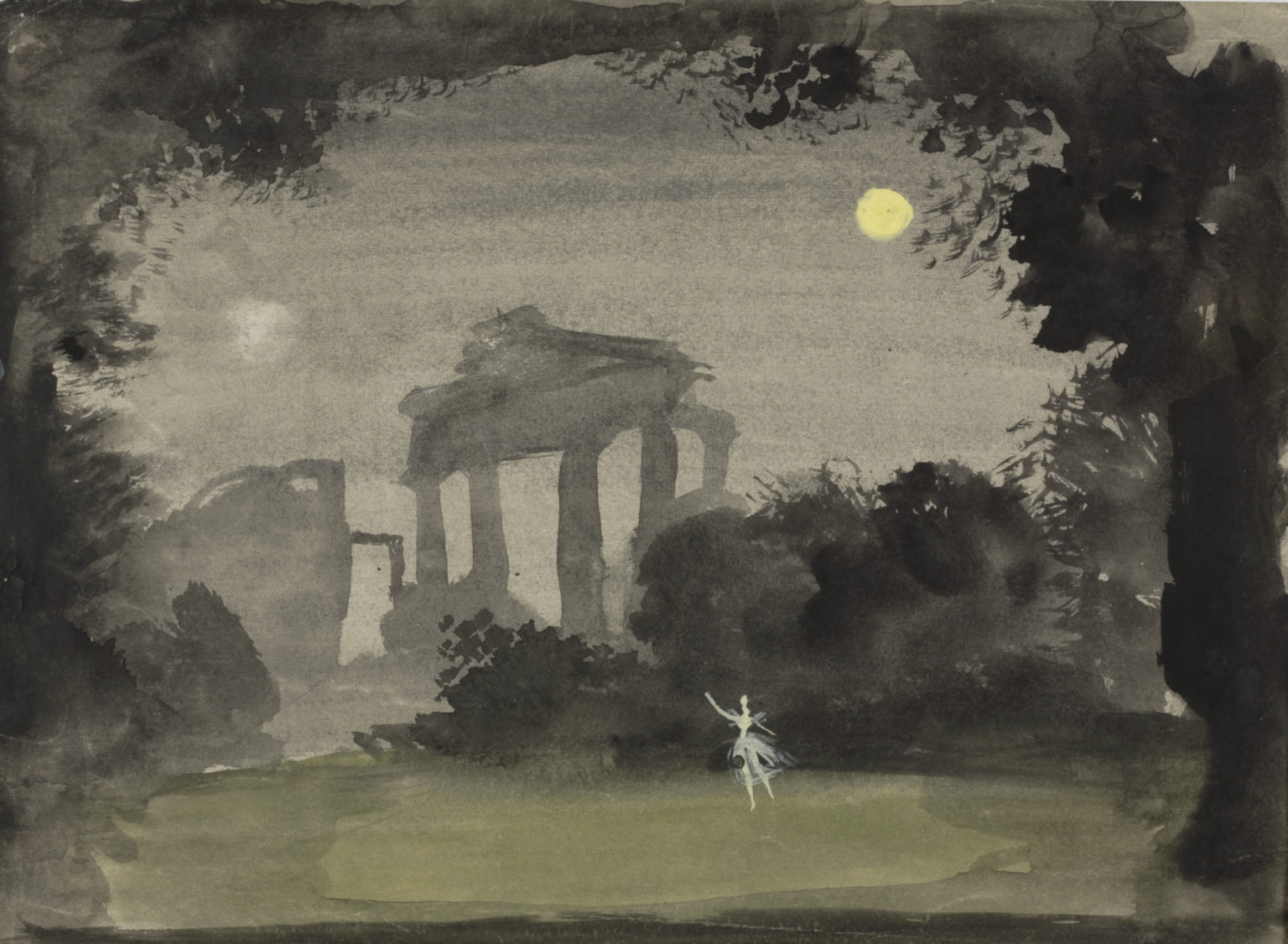


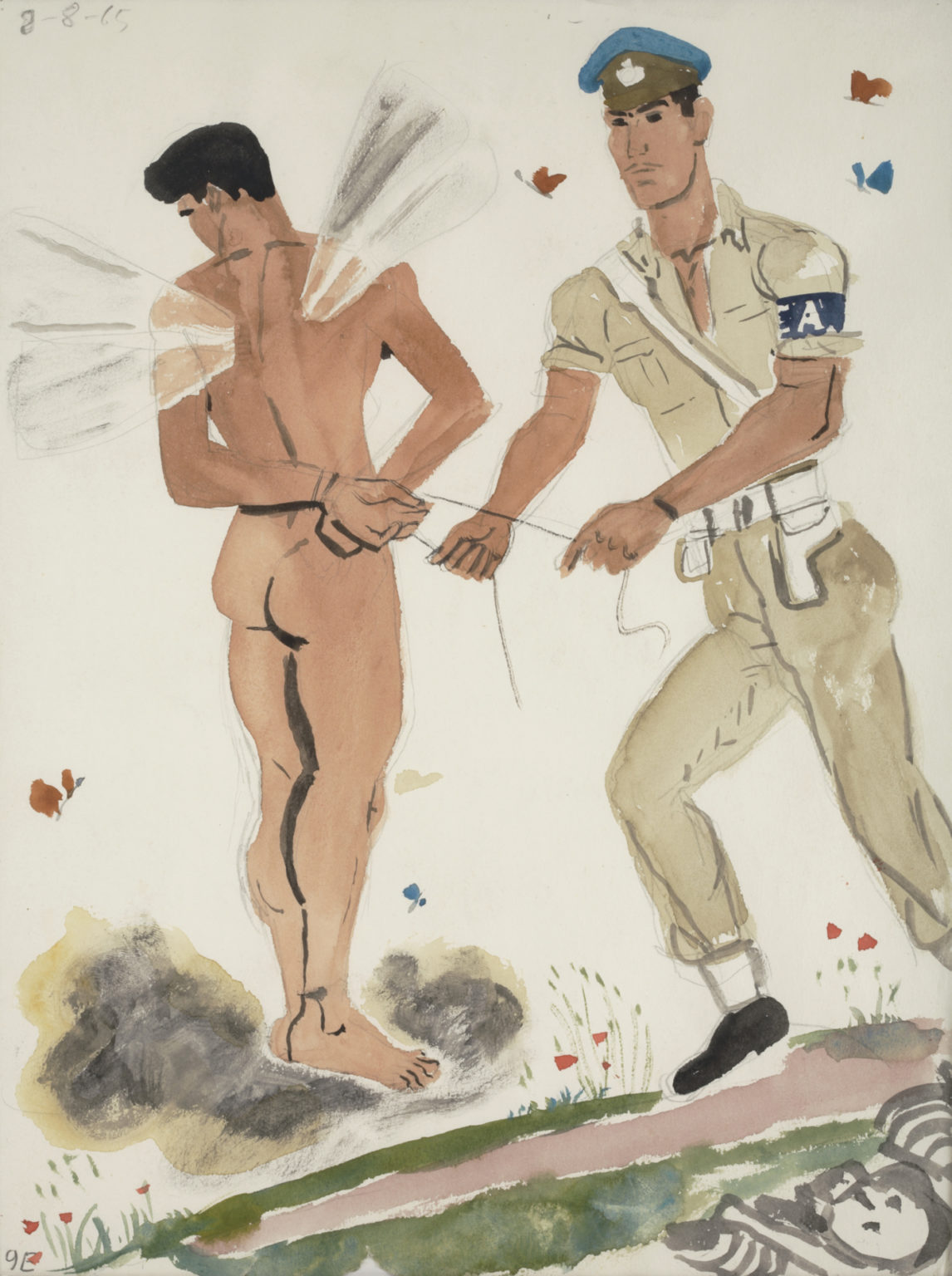
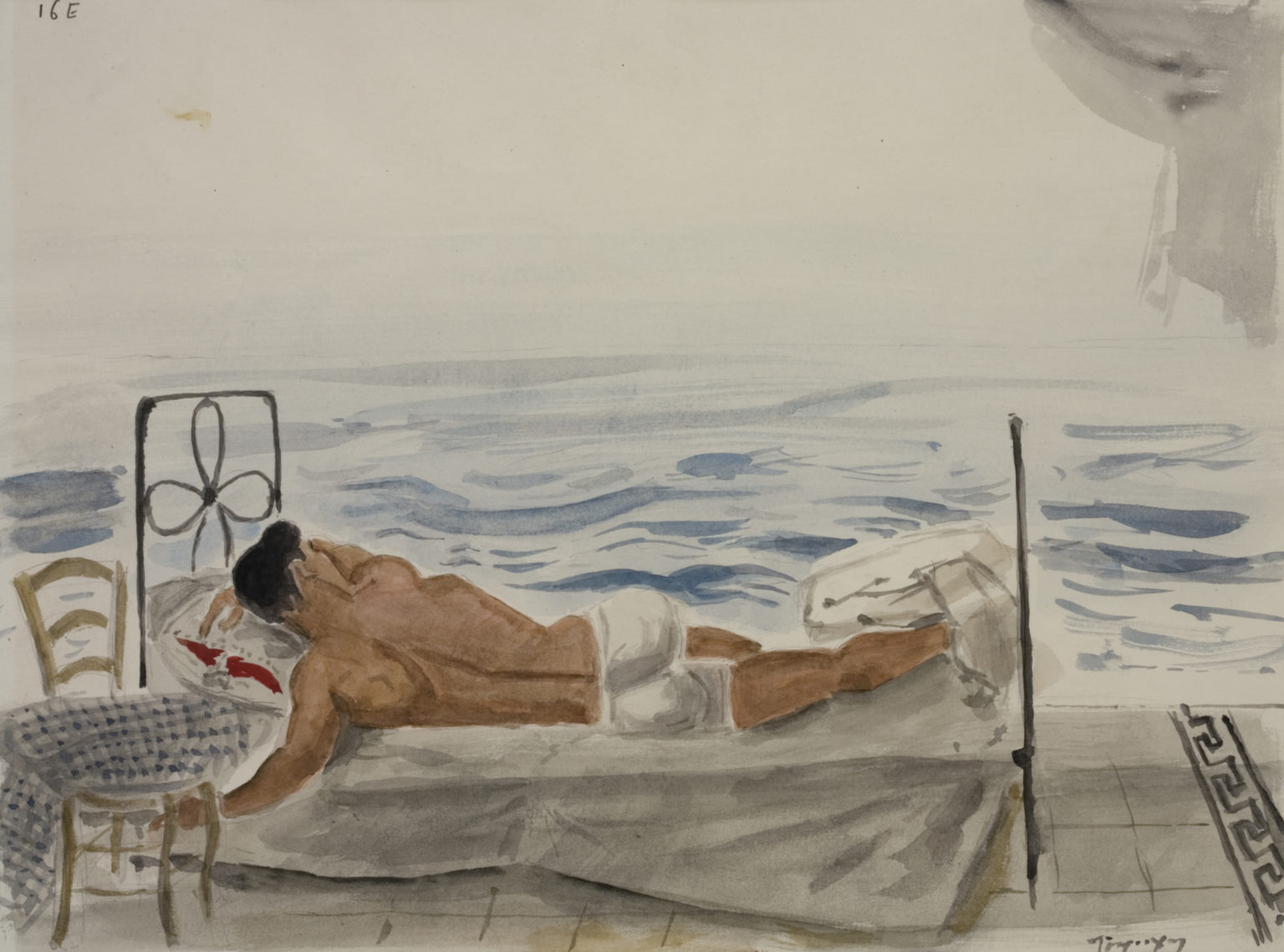
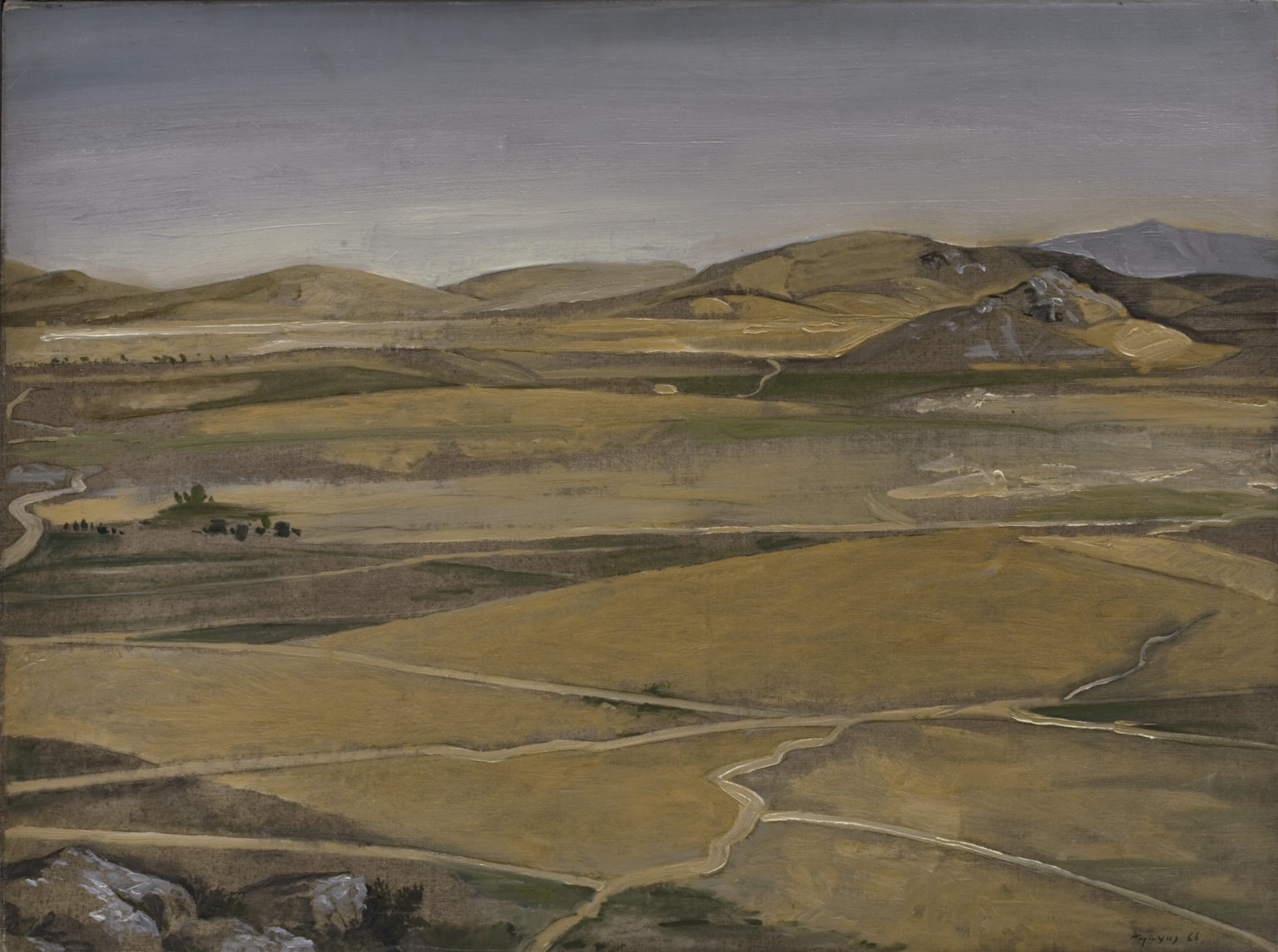
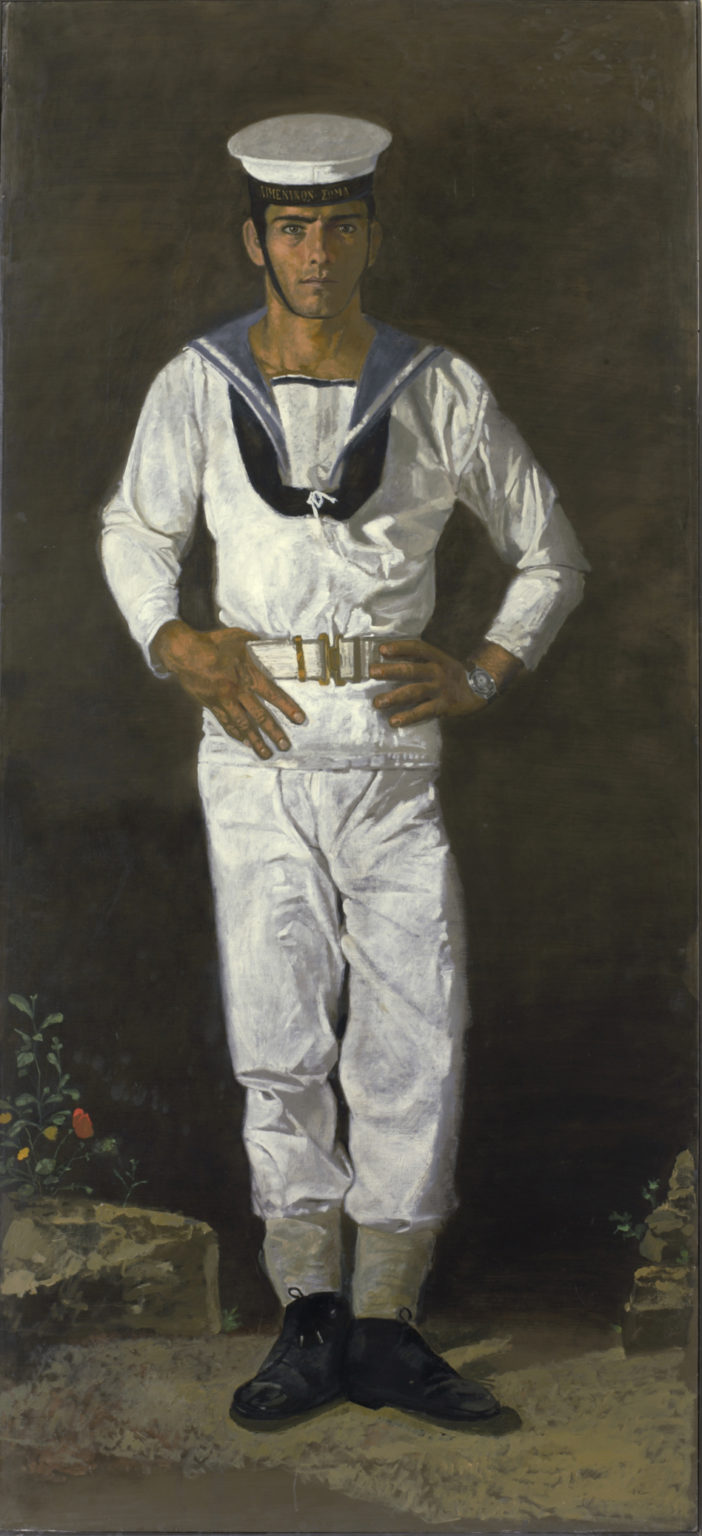

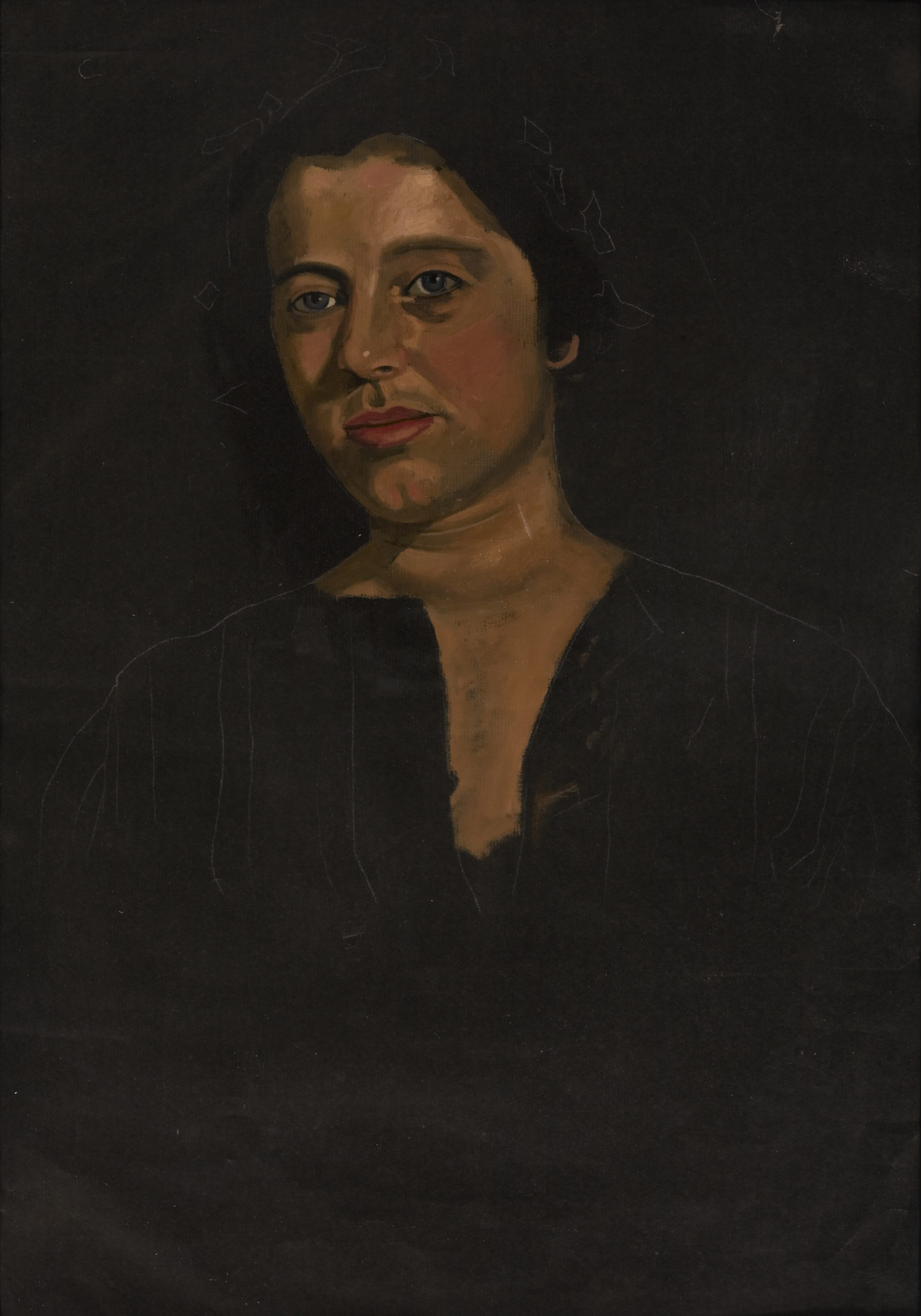
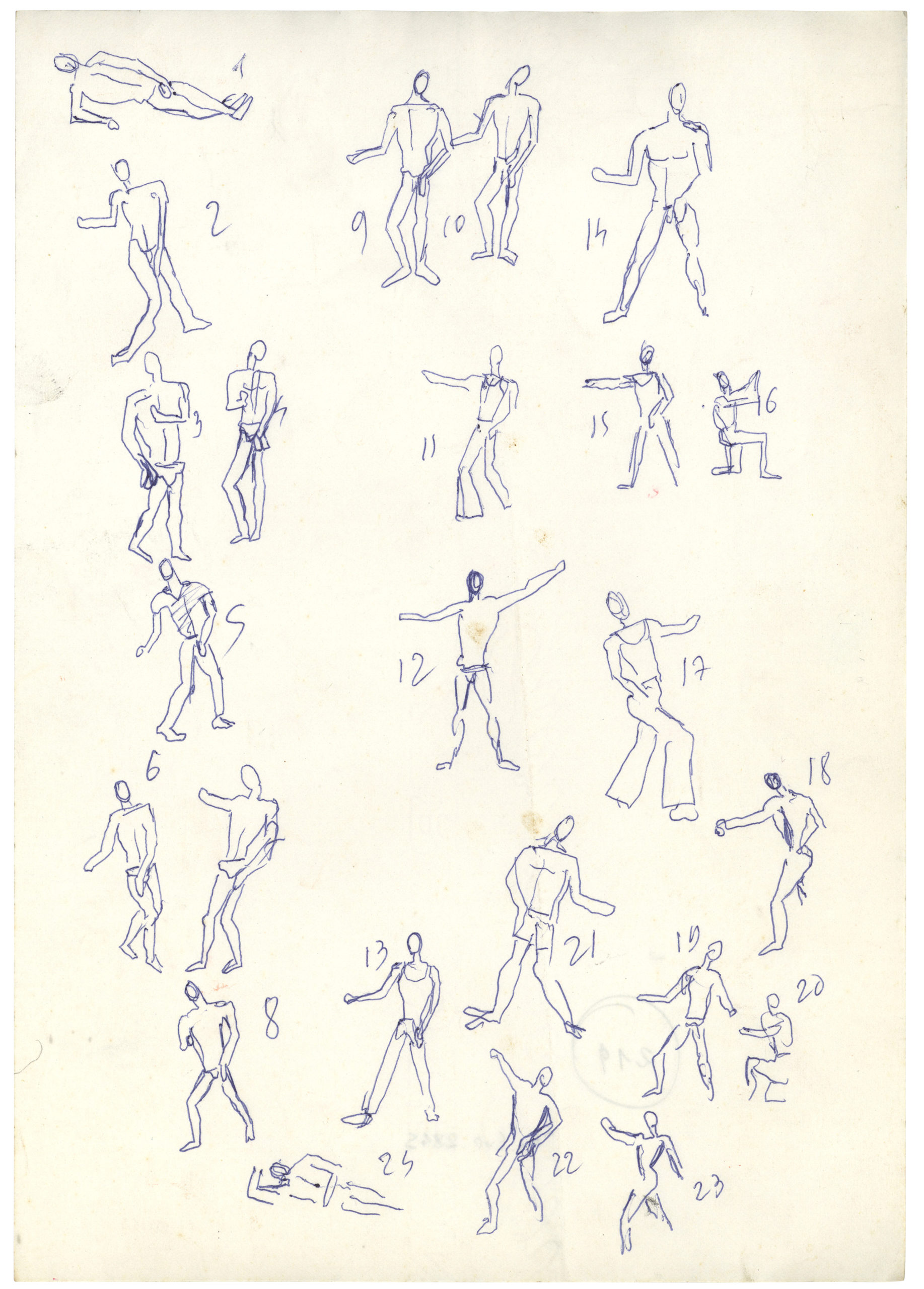


“Youth Posing as a Statue from Olympia,” (1939). Pigments with animal glue on canvas, 69 x 99 cm.
Though perhaps overlooked in the United States, Yannis Tsarouchis is widely regarded in his homeland of Greece as an important painter in the lineage of Modern art, offering an intriguing blend of abstract portraiture and surrealism. Incorporating Greek cultural vernacular into his paintings, sculptures, and designs for theatre during the burgeoning avant garde scene of his day, Tsarouchis produced a unique world of homoerotic fantasy. From May 7 to July 31, the Chicago gallery Wrightood 659 will be hosting the first US exhibition devoted to Tsarouchis’ works — entitled Yannis Tsarouchis: Dancing in Real Life.
Tsarouchis was born in Piraeus, a Greek port city on the outskirts of Athens’ sprawl. “To go for a walk in Piraeus at that time was like strolling in a gigantic stage set with rocks and fine houses adorned with statues and pediments,” Tsarouchis remembered. This immersion in traditional aesthetics drew Tsarouchis to the visual arts — at 18, he began formally studying the traditional techniques of greek sculpture, engraving, and painting. He also began to earn his living by designing sets for the theatre, which he would continue to do throughout his life.
However, his relationship with cultural pedagogy was soon challenged by an attraction to the more subversive, experimental ideas of the 20th century. Reconciling classical mores with notions of revolution and deconstruction, his signature aesthetic emerged. Evocative of both the present and the past — honoring cultural legacy without nostalgizing.
On the subject of this balance, Tsarouchis explained, “I soon stopped thinking it was an honour to contribute to the destruction of the old world. It was a long time before I realised that what had been demolished had rightly been demolished, but also that it would be stupid to destroy everything just out of a sense of ideological consistency.”
Tsarouchis’ relationship to cultural legacy was also doubtlessly challenged in years to come, as he fought on the front lines of the Greco-Italian war in 1940 and later fled Paris during the Greek military dictatorship of 1967-1974. During this self-imposed exile, he continued to study classical techniques and produce set designs for theatre. In the wake of his exile, he continued his prior work while splitting time between Paris and Athens. In 1981, he founded the Yannis Tsarouchis foundation out of his house in Maroussi, which became open to the public as the Tsarouchis museum in 1982. Tsarouchis later passed away in 1989, while preparing stage designs for Euripides’ Orestes.
All images courtesy of Wrightood 659 gallery and the Yannis Tsarouchis Foundation.
“Still Life with Umbrella,” (1928). Gouache on paper, 13.3 x 19.7 cm.
Though perhaps overlooked in the United States, Yannis Tsarouchis is widely regarded in his homeland of Greece as an important painter in the lineage of Modern art, offering an intriguing blend of abstract portraiture and surrealism. Incorporating Greek cultural vernacular into his paintings, sculptures, and designs for theatre during the burgeoning avant garde scene of his day, Tsarouchis produced a unique world of homoerotic fantasy. From May 7 to July 31, the Chicago gallery Wrightood 659 will be hosting the first US exhibition devoted to Tsarouchis’ works — entitled Yannis Tsarouchis: Dancing in Real Life.
Tsarouchis was born in Piraeus, a Greek port city on the outskirts of Athens’ sprawl. “To go for a walk in Piraeus at that time was like strolling in a gigantic stage set with rocks and fine houses adorned with statues and pediments,” Tsarouchis remembered. This immersion in traditional aesthetics drew Tsarouchis to the visual arts — at 18, he began formally studying the traditional techniques of greek sculpture, engraving, and painting. He also began to earn his living by designing sets for the theatre, which he would continue to do throughout his life.
However, his relationship with cultural pedagogy was soon challenged by an attraction to the more subversive, experimental ideas of the 20th century. Reconciling classical mores with notions of revolution and deconstruction, his signature aesthetic emerged. Evocative of both the present and the past — honoring cultural legacy without nostalgizing.
On the subject of this balance, Tsarouchis explained, “I soon stopped thinking it was an honour to contribute to the destruction of the old world. It was a long time before I realised that what had been demolished had rightly been demolished, but also that it would be stupid to destroy everything just out of a sense of ideological consistency.”
Tsarouchis’ relationship to cultural legacy was also doubtlessly challenged in years to come, as he fought on the front lines of the Greco-Italian war in 1940 and later fled Paris during the Greek military dictatorship of 1967-1974. During this self-imposed exile, he continued to study classical techniques and produce set designs for theatre. In the wake of his exile, he continued his prior work while splitting time between Paris and Athens. In 1981, he founded the Yannis Tsarouchis foundation out of his house in Maroussi, which became open to the public as the Tsarouchis museum in 1982. Tsarouchis later passed away in 1989, while preparing stage designs for Euripides’ Orestes.
All images courtesy of Wrightood 659 gallery and the Yannis Tsarouchis Foundation.
“The First Copy of the Medusa of Piraeus,” (1939‐1940). Gouache on paper, 23 x 22.5cm.
Though perhaps overlooked in the United States, Yannis Tsarouchis is widely regarded in his homeland of Greece as an important painter in the lineage of Modern art, offering an intriguing blend of abstract portraiture and surrealism. Incorporating Greek cultural vernacular into his paintings, sculptures, and designs for theatre during the burgeoning avant garde scene of his day, Tsarouchis produced a unique world of homoerotic fantasy. From May 7 to July 31, the Chicago gallery Wrightood 659 will be hosting the first US exhibition devoted to Tsarouchis’ works — entitled Yannis Tsarouchis: Dancing in Real Life.
Tsarouchis was born in Piraeus, a Greek port city on the outskirts of Athens’ sprawl. “To go for a walk in Piraeus at that time was like strolling in a gigantic stage set with rocks and fine houses adorned with statues and pediments,” Tsarouchis remembered. This immersion in traditional aesthetics drew Tsarouchis to the visual arts — at 18, he began formally studying the traditional techniques of greek sculpture, engraving, and painting. He also began to earn his living by designing sets for the theatre, which he would continue to do throughout his life.
However, his relationship with cultural pedagogy was soon challenged by an attraction to the more subversive, experimental ideas of the 20th century. Reconciling classical mores with notions of revolution and deconstruction, his signature aesthetic emerged. Evocative of both the present and the past — honoring cultural legacy without nostalgizing.
On the subject of this balance, Tsarouchis explained, “I soon stopped thinking it was an honour to contribute to the destruction of the old world. It was a long time before I realised that what had been demolished had rightly been demolished, but also that it would be stupid to destroy everything just out of a sense of ideological consistency.”
Tsarouchis’ relationship to cultural legacy was also doubtlessly challenged in years to come, as he fought on the front lines of the Greco-Italian war in 1940 and later fled Paris during the Greek military dictatorship of 1967-1974. During this self-imposed exile, he continued to study classical techniques and produce set designs for theatre. In the wake of his exile, he continued his prior work while splitting time between Paris and Athens. In 1981, he founded the Yannis Tsarouchis foundation out of his house in Maroussi, which became open to the public as the Tsarouchis museum in 1982. Tsarouchis later passed away in 1989, while preparing stage designs for Euripides’ Orestes.
All images courtesy of Wrightood 659 gallery and the Yannis Tsarouchis Foundation.
“Etching Proof, Centaurs and Lapiths,” (1936). Ink for etching on paper, 17.4-17.6 x 30.6 cm.
Though perhaps overlooked in the United States, Yannis Tsarouchis is widely regarded in his homeland of Greece as an important painter in the lineage of Modern art, offering an intriguing blend of abstract portraiture and surrealism. Incorporating Greek cultural vernacular into his paintings, sculptures, and designs for theatre during the burgeoning avant garde scene of his day, Tsarouchis produced a unique world of homoerotic fantasy. From May 7 to July 31, the Chicago gallery Wrightood 659 will be hosting the first US exhibition devoted to Tsarouchis’ works — entitled Yannis Tsarouchis: Dancing in Real Life.
Tsarouchis was born in Piraeus, a Greek port city on the outskirts of Athens’ sprawl. “To go for a walk in Piraeus at that time was like strolling in a gigantic stage set with rocks and fine houses adorned with statues and pediments,” Tsarouchis remembered. This immersion in traditional aesthetics drew Tsarouchis to the visual arts — at 18, he began formally studying the traditional techniques of greek sculpture, engraving, and painting. He also began to earn his living by designing sets for the theatre, which he would continue to do throughout his life.
However, his relationship with cultural pedagogy was soon challenged by an attraction to the more subversive, experimental ideas of the 20th century. Reconciling classical mores with notions of revolution and deconstruction, his signature aesthetic emerged. Evocative of both the present and the past — honoring cultural legacy without nostalgizing.
On the subject of this balance, Tsarouchis explained, “I soon stopped thinking it was an honour to contribute to the destruction of the old world. It was a long time before I realised that what had been demolished had rightly been demolished, but also that it would be stupid to destroy everything just out of a sense of ideological consistency.”
Tsarouchis’ relationship to cultural legacy was also doubtlessly challenged in years to come, as he fought on the front lines of the Greco-Italian war in 1940 and later fled Paris during the Greek military dictatorship of 1967-1974. During this self-imposed exile, he continued to study classical techniques and produce set designs for theatre. In the wake of his exile, he continued his prior work while splitting time between Paris and Athens. In 1981, he founded the Yannis Tsarouchis foundation out of his house in Maroussi, which became open to the public as the Tsarouchis museum in 1982. Tsarouchis later passed away in 1989, while preparing stage designs for Euripides’ Orestes.
All images courtesy of Wrightood 659 gallery and the Yannis Tsarouchis Foundation.
“Set Design for As You Like It by William Shakespeare,” (1937). Watercolor on paper, 13 x 22 cm.
Though perhaps overlooked in the United States, Yannis Tsarouchis is widely regarded in his homeland of Greece as an important painter in the lineage of Modern art, offering an intriguing blend of abstract portraiture and surrealism. Incorporating Greek cultural vernacular into his paintings, sculptures, and designs for theatre during the burgeoning avant garde scene of his day, Tsarouchis produced a unique world of homoerotic fantasy. From May 7 to July 31, the Chicago gallery Wrightood 659 will be hosting the first US exhibition devoted to Tsarouchis’ works — entitled Yannis Tsarouchis: Dancing in Real Life.
Tsarouchis was born in Piraeus, a Greek port city on the outskirts of Athens’ sprawl. “To go for a walk in Piraeus at that time was like strolling in a gigantic stage set with rocks and fine houses adorned with statues and pediments,” Tsarouchis remembered. This immersion in traditional aesthetics drew Tsarouchis to the visual arts — at 18, he began formally studying the traditional techniques of greek sculpture, engraving, and painting. He also began to earn his living by designing sets for the theatre, which he would continue to do throughout his life.
However, his relationship with cultural pedagogy was soon challenged by an attraction to the more subversive, experimental ideas of the 20th century. Reconciling classical mores with notions of revolution and deconstruction, his signature aesthetic emerged. Evocative of both the present and the past — honoring cultural legacy without nostalgizing.
On the subject of this balance, Tsarouchis explained, “I soon stopped thinking it was an honour to contribute to the destruction of the old world. It was a long time before I realised that what had been demolished had rightly been demolished, but also that it would be stupid to destroy everything just out of a sense of ideological consistency.”
Tsarouchis’ relationship to cultural legacy was also doubtlessly challenged in years to come, as he fought on the front lines of the Greco-Italian war in 1940 and later fled Paris during the Greek military dictatorship of 1967-1974. During this self-imposed exile, he continued to study classical techniques and produce set designs for theatre. In the wake of his exile, he continued his prior work while splitting time between Paris and Athens. In 1981, he founded the Yannis Tsarouchis foundation out of his house in Maroussi, which became open to the public as the Tsarouchis museum in 1982. Tsarouchis later passed away in 1989, while preparing stage designs for Euripides’ Orestes.
All images courtesy of Wrightood 659 gallery and the Yannis Tsarouchis Foundation.
“The arrest of three communists, who are reacting accordingly. The first has surrendered, the second is struggling and the third one is under the bed. First days of the 1944 uprising. (1944). Watercolor on paper, 17.4 x 25.8 cm.
Though perhaps overlooked in the United States, Yannis Tsarouchis is widely regarded in his homeland of Greece as an important painter in the lineage of Modern art, offering an intriguing blend of abstract portraiture and surrealism. Incorporating Greek cultural vernacular into his paintings, sculptures, and designs for theatre during the burgeoning avant garde scene of his day, Tsarouchis produced a unique world of homoerotic fantasy. From May 7 to July 31, the Chicago gallery Wrightood 659 will be hosting the first US exhibition devoted to Tsarouchis’ works — entitled Yannis Tsarouchis: Dancing in Real Life.
Tsarouchis was born in Piraeus, a Greek port city on the outskirts of Athens’ sprawl. “To go for a walk in Piraeus at that time was like strolling in a gigantic stage set with rocks and fine houses adorned with statues and pediments,” Tsarouchis remembered. This immersion in traditional aesthetics drew Tsarouchis to the visual arts — at 18, he began formally studying the traditional techniques of greek sculpture, engraving, and painting. He also began to earn his living by designing sets for the theatre, which he would continue to do throughout his life.
However, his relationship with cultural pedagogy was soon challenged by an attraction to the more subversive, experimental ideas of the 20th century. Reconciling classical mores with notions of revolution and deconstruction, his signature aesthetic emerged. Evocative of both the present and the past — honoring cultural legacy without nostalgizing.
On the subject of this balance, Tsarouchis explained, “I soon stopped thinking it was an honour to contribute to the destruction of the old world. It was a long time before I realised that what had been demolished had rightly been demolished, but also that it would be stupid to destroy everything just out of a sense of ideological consistency.”
Tsarouchis’ relationship to cultural legacy was also doubtlessly challenged in years to come, as he fought on the front lines of the Greco-Italian war in 1940 and later fled Paris during the Greek military dictatorship of 1967-1974. During this self-imposed exile, he continued to study classical techniques and produce set designs for theatre. In the wake of his exile, he continued his prior work while splitting time between Paris and Athens. In 1981, he founded the Yannis Tsarouchis foundation out of his house in Maroussi, which became open to the public as the Tsarouchis museum in 1982. Tsarouchis later passed away in 1989, while preparing stage designs for Euripides’ Orestes.
All images courtesy of Wrightood 659 gallery and the Yannis Tsarouchis Foundation.
“Set Design for Les Sylphides by Frédéric Chopin,” (1948). Gouache on paper, 26.8 x 36.8 cm.
Though perhaps overlooked in the United States, Yannis Tsarouchis is widely regarded in his homeland of Greece as an important painter in the lineage of Modern art, offering an intriguing blend of abstract portraiture and surrealism. Incorporating Greek cultural vernacular into his paintings, sculptures, and designs for theatre during the burgeoning avant garde scene of his day, Tsarouchis produced a unique world of homoerotic fantasy. From May 7 to July 31, the Chicago gallery Wrightood 659 will be hosting the first US exhibition devoted to Tsarouchis’ works — entitled Yannis Tsarouchis: Dancing in Real Life.
Tsarouchis was born in Piraeus, a Greek port city on the outskirts of Athens’ sprawl. “To go for a walk in Piraeus at that time was like strolling in a gigantic stage set with rocks and fine houses adorned with statues and pediments,” Tsarouchis remembered. This immersion in traditional aesthetics drew Tsarouchis to the visual arts — at 18, he began formally studying the traditional techniques of greek sculpture, engraving, and painting. He also began to earn his living by designing sets for the theatre, which he would continue to do throughout his life.
However, his relationship with cultural pedagogy was soon challenged by an attraction to the more subversive, experimental ideas of the 20th century. Reconciling classical mores with notions of revolution and deconstruction, his signature aesthetic emerged. Evocative of both the present and the past — honoring cultural legacy without nostalgizing.
On the subject of this balance, Tsarouchis explained, “I soon stopped thinking it was an honour to contribute to the destruction of the old world. It was a long time before I realised that what had been demolished had rightly been demolished, but also that it would be stupid to destroy everything just out of a sense of ideological consistency.”
Tsarouchis’ relationship to cultural legacy was also doubtlessly challenged in years to come, as he fought on the front lines of the Greco-Italian war in 1940 and later fled Paris during the Greek military dictatorship of 1967-1974. During this self-imposed exile, he continued to study classical techniques and produce set designs for theatre. In the wake of his exile, he continued his prior work while splitting time between Paris and Athens. In 1981, he founded the Yannis Tsarouchis foundation out of his house in Maroussi, which became open to the public as the Tsarouchis museum in 1982. Tsarouchis later passed away in 1989, while preparing stage designs for Euripides’ Orestes.
All images courtesy of Wrightood 659 gallery and the Yannis Tsarouchis Foundation.
“Alexandras Square in Piraeus,” (1962). Pigments mixed with animal glue on canvas, 88.5 x 158.5 cm.
Though perhaps overlooked in the United States, Yannis Tsarouchis is widely regarded in his homeland of Greece as an important painter in the lineage of Modern art, offering an intriguing blend of abstract portraiture and surrealism. Incorporating Greek cultural vernacular into his paintings, sculptures, and designs for theatre during the burgeoning avant garde scene of his day, Tsarouchis produced a unique world of homoerotic fantasy. From May 7 to July 31, the Chicago gallery Wrightood 659 will be hosting the first US exhibition devoted to Tsarouchis’ works — entitled Yannis Tsarouchis: Dancing in Real Life.
Tsarouchis was born in Piraeus, a Greek port city on the outskirts of Athens’ sprawl. “To go for a walk in Piraeus at that time was like strolling in a gigantic stage set with rocks and fine houses adorned with statues and pediments,” Tsarouchis remembered. This immersion in traditional aesthetics drew Tsarouchis to the visual arts — at 18, he began formally studying the traditional techniques of greek sculpture, engraving, and painting. He also began to earn his living by designing sets for the theatre, which he would continue to do throughout his life.
However, his relationship with cultural pedagogy was soon challenged by an attraction to the more subversive, experimental ideas of the 20th century. Reconciling classical mores with notions of revolution and deconstruction, his signature aesthetic emerged. Evocative of both the present and the past — honoring cultural legacy without nostalgizing.
On the subject of this balance, Tsarouchis explained, “I soon stopped thinking it was an honour to contribute to the destruction of the old world. It was a long time before I realised that what had been demolished had rightly been demolished, but also that it would be stupid to destroy everything just out of a sense of ideological consistency.”
Tsarouchis’ relationship to cultural legacy was also doubtlessly challenged in years to come, as he fought on the front lines of the Greco-Italian war in 1940 and later fled Paris during the Greek military dictatorship of 1967-1974. During this self-imposed exile, he continued to study classical techniques and produce set designs for theatre. In the wake of his exile, he continued his prior work while splitting time between Paris and Athens. In 1981, he founded the Yannis Tsarouchis foundation out of his house in Maroussi, which became open to the public as the Tsarouchis museum in 1982. Tsarouchis later passed away in 1989, while preparing stage designs for Euripides’ Orestes.
All images courtesy of Wrightood 659 gallery and the Yannis Tsarouchis Foundation.
“Dancing in Real Life and in Theatre,” (1963‐1968). Oil on canvas, 60 x 212.5 cm.
Though perhaps overlooked in the United States, Yannis Tsarouchis is widely regarded in his homeland of Greece as an important painter in the lineage of Modern art, offering an intriguing blend of abstract portraiture and surrealism. Incorporating Greek cultural vernacular into his paintings, sculptures, and designs for theatre during the burgeoning avant garde scene of his day, Tsarouchis produced a unique world of homoerotic fantasy. From May 7 to July 31, the Chicago gallery Wrightood 659 will be hosting the first US exhibition devoted to Tsarouchis’ works — entitled Yannis Tsarouchis: Dancing in Real Life.
Tsarouchis was born in Piraeus, a Greek port city on the outskirts of Athens’ sprawl. “To go for a walk in Piraeus at that time was like strolling in a gigantic stage set with rocks and fine houses adorned with statues and pediments,” Tsarouchis remembered. This immersion in traditional aesthetics drew Tsarouchis to the visual arts — at 18, he began formally studying the traditional techniques of greek sculpture, engraving, and painting. He also began to earn his living by designing sets for the theatre, which he would continue to do throughout his life.
However, his relationship with cultural pedagogy was soon challenged by an attraction to the more subversive, experimental ideas of the 20th century. Reconciling classical mores with notions of revolution and deconstruction, his signature aesthetic emerged. Evocative of both the present and the past — honoring cultural legacy without nostalgizing.
On the subject of this balance, Tsarouchis explained, “I soon stopped thinking it was an honour to contribute to the destruction of the old world. It was a long time before I realised that what had been demolished had rightly been demolished, but also that it would be stupid to destroy everything just out of a sense of ideological consistency.”
Tsarouchis’ relationship to cultural legacy was also doubtlessly challenged in years to come, as he fought on the front lines of the Greco-Italian war in 1940 and later fled Paris during the Greek military dictatorship of 1967-1974. During this self-imposed exile, he continued to study classical techniques and produce set designs for theatre. In the wake of his exile, he continued his prior work while splitting time between Paris and Athens. In 1981, he founded the Yannis Tsarouchis foundation out of his house in Maroussi, which became open to the public as the Tsarouchis museum in 1982. Tsarouchis later passed away in 1989, while preparing stage designs for Euripides’ Orestes.
All images courtesy of Wrightood 659 gallery and the Yannis Tsarouchis Foundation.
“Military Policeman Arresting the Spirit,” (1965). Watercolor and pencil on paper, 32.5 x 24.7 cm.
Though perhaps overlooked in the United States, Yannis Tsarouchis is widely regarded in his homeland of Greece as an important painter in the lineage of Modern art, offering an intriguing blend of abstract portraiture and surrealism. Incorporating Greek cultural vernacular into his paintings, sculptures, and designs for theatre during the burgeoning avant garde scene of his day, Tsarouchis produced a unique world of homoerotic fantasy. From May 7 to July 31, the Chicago gallery Wrightood 659 will be hosting the first US exhibition devoted to Tsarouchis’ works — entitled Yannis Tsarouchis: Dancing in Real Life.
Tsarouchis was born in Piraeus, a Greek port city on the outskirts of Athens’ sprawl. “To go for a walk in Piraeus at that time was like strolling in a gigantic stage set with rocks and fine houses adorned with statues and pediments,” Tsarouchis remembered. This immersion in traditional aesthetics drew Tsarouchis to the visual arts — at 18, he began formally studying the traditional techniques of greek sculpture, engraving, and painting. He also began to earn his living by designing sets for the theatre, which he would continue to do throughout his life.
However, his relationship with cultural pedagogy was soon challenged by an attraction to the more subversive, experimental ideas of the 20th century. Reconciling classical mores with notions of revolution and deconstruction, his signature aesthetic emerged. Evocative of both the present and the past — honoring cultural legacy without nostalgizing.
On the subject of this balance, Tsarouchis explained, “I soon stopped thinking it was an honour to contribute to the destruction of the old world. It was a long time before I realised that what had been demolished had rightly been demolished, but also that it would be stupid to destroy everything just out of a sense of ideological consistency.”
Tsarouchis’ relationship to cultural legacy was also doubtlessly challenged in years to come, as he fought on the front lines of the Greco-Italian war in 1940 and later fled Paris during the Greek military dictatorship of 1967-1974. During this self-imposed exile, he continued to study classical techniques and produce set designs for theatre. In the wake of his exile, he continued his prior work while splitting time between Paris and Athens. In 1981, he founded the Yannis Tsarouchis foundation out of his house in Maroussi, which became open to the public as the Tsarouchis museum in 1982. Tsarouchis later passed away in 1989, while preparing stage designs for Euripides’ Orestes.
All images courtesy of Wrightood 659 gallery and the Yannis Tsarouchis Foundation.
“Youth Asleep by the Sea,” (1965). Watercolor on paper, 24 x 31.5 cm.
Though perhaps overlooked in the United States, Yannis Tsarouchis is widely regarded in his homeland of Greece as an important painter in the lineage of Modern art, offering an intriguing blend of abstract portraiture and surrealism. Incorporating Greek cultural vernacular into his paintings, sculptures, and designs for theatre during the burgeoning avant garde scene of his day, Tsarouchis produced a unique world of homoerotic fantasy. From May 7 to July 31, the Chicago gallery Wrightood 659 will be hosting the first US exhibition devoted to Tsarouchis’ works — entitled Yannis Tsarouchis: Dancing in Real Life.
Tsarouchis was born in Piraeus, a Greek port city on the outskirts of Athens’ sprawl. “To go for a walk in Piraeus at that time was like strolling in a gigantic stage set with rocks and fine houses adorned with statues and pediments,” Tsarouchis remembered. This immersion in traditional aesthetics drew Tsarouchis to the visual arts — at 18, he began formally studying the traditional techniques of greek sculpture, engraving, and painting. He also began to earn his living by designing sets for the theatre, which he would continue to do throughout his life.
However, his relationship with cultural pedagogy was soon challenged by an attraction to the more subversive, experimental ideas of the 20th century. Reconciling classical mores with notions of revolution and deconstruction, his signature aesthetic emerged. Evocative of both the present and the past — honoring cultural legacy without nostalgizing.
On the subject of this balance, Tsarouchis explained, “I soon stopped thinking it was an honour to contribute to the destruction of the old world. It was a long time before I realised that what had been demolished had rightly been demolished, but also that it would be stupid to destroy everything just out of a sense of ideological consistency.”
Tsarouchis’ relationship to cultural legacy was also doubtlessly challenged in years to come, as he fought on the front lines of the Greco-Italian war in 1940 and later fled Paris during the Greek military dictatorship of 1967-1974. During this self-imposed exile, he continued to study classical techniques and produce set designs for theatre. In the wake of his exile, he continued his prior work while splitting time between Paris and Athens. In 1981, he founded the Yannis Tsarouchis foundation out of his house in Maroussi, which became open to the public as the Tsarouchis museum in 1982. Tsarouchis later passed away in 1989, while preparing stage designs for Euripides’ Orestes.
All images courtesy of Wrightood 659 gallery and the Yannis Tsarouchis Foundation.
“Attica Landscape,” (1966). Oil on canvas, 74.5 x 100 cm.
Though perhaps overlooked in the United States, Yannis Tsarouchis is widely regarded in his homeland of Greece as an important painter in the lineage of Modern art, offering an intriguing blend of abstract portraiture and surrealism. Incorporating Greek cultural vernacular into his paintings, sculptures, and designs for theatre during the burgeoning avant garde scene of his day, Tsarouchis produced a unique world of homoerotic fantasy. From May 7 to July 31, the Chicago gallery Wrightood 659 will be hosting the first US exhibition devoted to Tsarouchis’ works — entitled Yannis Tsarouchis: Dancing in Real Life.
Tsarouchis was born in Piraeus, a Greek port city on the outskirts of Athens’ sprawl. “To go for a walk in Piraeus at that time was like strolling in a gigantic stage set with rocks and fine houses adorned with statues and pediments,” Tsarouchis remembered. This immersion in traditional aesthetics drew Tsarouchis to the visual arts — at 18, he began formally studying the traditional techniques of greek sculpture, engraving, and painting. He also began to earn his living by designing sets for the theatre, which he would continue to do throughout his life.
However, his relationship with cultural pedagogy was soon challenged by an attraction to the more subversive, experimental ideas of the 20th century. Reconciling classical mores with notions of revolution and deconstruction, his signature aesthetic emerged. Evocative of both the present and the past — honoring cultural legacy without nostalgizing.
On the subject of this balance, Tsarouchis explained, “I soon stopped thinking it was an honour to contribute to the destruction of the old world. It was a long time before I realised that what had been demolished had rightly been demolished, but also that it would be stupid to destroy everything just out of a sense of ideological consistency.”
Tsarouchis’ relationship to cultural legacy was also doubtlessly challenged in years to come, as he fought on the front lines of the Greco-Italian war in 1940 and later fled Paris during the Greek military dictatorship of 1967-1974. During this self-imposed exile, he continued to study classical techniques and produce set designs for theatre. In the wake of his exile, he continued his prior work while splitting time between Paris and Athens. In 1981, he founded the Yannis Tsarouchis foundation out of his house in Maroussi, which became open to the public as the Tsarouchis museum in 1982. Tsarouchis later passed away in 1989, while preparing stage designs for Euripides’ Orestes.
All images courtesy of Wrightood 659 gallery and the Yannis Tsarouchis Foundation.
“Sailor in the Sun,” (1968-1970). Oil on canvas, 223.5 x 104 cm.
Though perhaps overlooked in the United States, Yannis Tsarouchis is widely regarded in his homeland of Greece as an important painter in the lineage of Modern art, offering an intriguing blend of abstract portraiture and surrealism. Incorporating Greek cultural vernacular into his paintings, sculptures, and designs for theatre during the burgeoning avant garde scene of his day, Tsarouchis produced a unique world of homoerotic fantasy. From May 7 to July 31, the Chicago gallery Wrightood 659 will be hosting the first US exhibition devoted to Tsarouchis’ works — entitled Yannis Tsarouchis: Dancing in Real Life.
Tsarouchis was born in Piraeus, a Greek port city on the outskirts of Athens’ sprawl. “To go for a walk in Piraeus at that time was like strolling in a gigantic stage set with rocks and fine houses adorned with statues and pediments,” Tsarouchis remembered. This immersion in traditional aesthetics drew Tsarouchis to the visual arts — at 18, he began formally studying the traditional techniques of greek sculpture, engraving, and painting. He also began to earn his living by designing sets for the theatre, which he would continue to do throughout his life.
However, his relationship with cultural pedagogy was soon challenged by an attraction to the more subversive, experimental ideas of the 20th century. Reconciling classical mores with notions of revolution and deconstruction, his signature aesthetic emerged. Evocative of both the present and the past — honoring cultural legacy without nostalgizing.
On the subject of this balance, Tsarouchis explained, “I soon stopped thinking it was an honour to contribute to the destruction of the old world. It was a long time before I realised that what had been demolished had rightly been demolished, but also that it would be stupid to destroy everything just out of a sense of ideological consistency.”
Tsarouchis’ relationship to cultural legacy was also doubtlessly challenged in years to come, as he fought on the front lines of the Greco-Italian war in 1940 and later fled Paris during the Greek military dictatorship of 1967-1974. During this self-imposed exile, he continued to study classical techniques and produce set designs for theatre. In the wake of his exile, he continued his prior work while splitting time between Paris and Athens. In 1981, he founded the Yannis Tsarouchis foundation out of his house in Maroussi, which became open to the public as the Tsarouchis museum in 1982. Tsarouchis later passed away in 1989, while preparing stage designs for Euripides’ Orestes.
All images courtesy of Wrightood 659 gallery and the Yannis Tsarouchis Foundation.
“Semi-nude Pianist,” (1969). Gouache on paper, 30.7 x 30.6 cm.
Though perhaps overlooked in the United States, Yannis Tsarouchis is widely regarded in his homeland of Greece as an important painter in the lineage of Modern art, offering an intriguing blend of abstract portraiture and surrealism. Incorporating Greek cultural vernacular into his paintings, sculptures, and designs for theatre during the burgeoning avant garde scene of his day, Tsarouchis produced a unique world of homoerotic fantasy. From May 7 to July 31, the Chicago gallery Wrightood 659 will be hosting the first US exhibition devoted to Tsarouchis’ works — entitled Yannis Tsarouchis: Dancing in Real Life.
Tsarouchis was born in Piraeus, a Greek port city on the outskirts of Athens’ sprawl. “To go for a walk in Piraeus at that time was like strolling in a gigantic stage set with rocks and fine houses adorned with statues and pediments,” Tsarouchis remembered. This immersion in traditional aesthetics drew Tsarouchis to the visual arts — at 18, he began formally studying the traditional techniques of greek sculpture, engraving, and painting. He also began to earn his living by designing sets for the theatre, which he would continue to do throughout his life.
However, his relationship with cultural pedagogy was soon challenged by an attraction to the more subversive, experimental ideas of the 20th century. Reconciling classical mores with notions of revolution and deconstruction, his signature aesthetic emerged. Evocative of both the present and the past — honoring cultural legacy without nostalgizing.
On the subject of this balance, Tsarouchis explained, “I soon stopped thinking it was an honour to contribute to the destruction of the old world. It was a long time before I realised that what had been demolished had rightly been demolished, but also that it would be stupid to destroy everything just out of a sense of ideological consistency.”
Tsarouchis’ relationship to cultural legacy was also doubtlessly challenged in years to come, as he fought on the front lines of the Greco-Italian war in 1940 and later fled Paris during the Greek military dictatorship of 1967-1974. During this self-imposed exile, he continued to study classical techniques and produce set designs for theatre. In the wake of his exile, he continued his prior work while splitting time between Paris and Athens. In 1981, he founded the Yannis Tsarouchis foundation out of his house in Maroussi, which became open to the public as the Tsarouchis museum in 1982. Tsarouchis later passed away in 1989, while preparing stage designs for Euripides’ Orestes.
All images courtesy of Wrightood 659 gallery and the Yannis Tsarouchis Foundation.
“Study of Korina for Autumn by Candle Light,” (1970-1971). Oil on paper, 60.5 x 42 cm.
Though perhaps overlooked in the United States, Yannis Tsarouchis is widely regarded in his homeland of Greece as an important painter in the lineage of Modern art, offering an intriguing blend of abstract portraiture and surrealism. Incorporating Greek cultural vernacular into his paintings, sculptures, and designs for theatre during the burgeoning avant garde scene of his day, Tsarouchis produced a unique world of homoerotic fantasy. From May 7 to July 31, the Chicago gallery Wrightood 659 will be hosting the first US exhibition devoted to Tsarouchis’ works — entitled Yannis Tsarouchis: Dancing in Real Life.
Tsarouchis was born in Piraeus, a Greek port city on the outskirts of Athens’ sprawl. “To go for a walk in Piraeus at that time was like strolling in a gigantic stage set with rocks and fine houses adorned with statues and pediments,” Tsarouchis remembered. This immersion in traditional aesthetics drew Tsarouchis to the visual arts — at 18, he began formally studying the traditional techniques of greek sculpture, engraving, and painting. He also began to earn his living by designing sets for the theatre, which he would continue to do throughout his life.
However, his relationship with cultural pedagogy was soon challenged by an attraction to the more subversive, experimental ideas of the 20th century. Reconciling classical mores with notions of revolution and deconstruction, his signature aesthetic emerged. Evocative of both the present and the past — honoring cultural legacy without nostalgizing.
On the subject of this balance, Tsarouchis explained, “I soon stopped thinking it was an honour to contribute to the destruction of the old world. It was a long time before I realised that what had been demolished had rightly been demolished, but also that it would be stupid to destroy everything just out of a sense of ideological consistency.”
Tsarouchis’ relationship to cultural legacy was also doubtlessly challenged in years to come, as he fought on the front lines of the Greco-Italian war in 1940 and later fled Paris during the Greek military dictatorship of 1967-1974. During this self-imposed exile, he continued to study classical techniques and produce set designs for theatre. In the wake of his exile, he continued his prior work while splitting time between Paris and Athens. In 1981, he founded the Yannis Tsarouchis foundation out of his house in Maroussi, which became open to the public as the Tsarouchis museum in 1982. Tsarouchis later passed away in 1989, while preparing stage designs for Euripides’ Orestes.
All images courtesy of Wrightood 659 gallery and the Yannis Tsarouchis Foundation.
“Figures for Zeimbekiko Dance,” (1970’s). Pen on paper, 29.7 x 21 cm.
Though perhaps overlooked in the United States, Yannis Tsarouchis is widely regarded in his homeland of Greece as an important painter in the lineage of Modern art, offering an intriguing blend of abstract portraiture and surrealism. Incorporating Greek cultural vernacular into his paintings, sculptures, and designs for theatre during the burgeoning avant garde scene of his day, Tsarouchis produced a unique world of homoerotic fantasy. From May 7 to July 31, the Chicago gallery Wrightood 659 will be hosting the first US exhibition devoted to Tsarouchis’ works — entitled Yannis Tsarouchis: Dancing in Real Life.
Tsarouchis was born in Piraeus, a Greek port city on the outskirts of Athens’ sprawl. “To go for a walk in Piraeus at that time was like strolling in a gigantic stage set with rocks and fine houses adorned with statues and pediments,” Tsarouchis remembered. This immersion in traditional aesthetics drew Tsarouchis to the visual arts — at 18, he began formally studying the traditional techniques of greek sculpture, engraving, and painting. He also began to earn his living by designing sets for the theatre, which he would continue to do throughout his life.
However, his relationship with cultural pedagogy was soon challenged by an attraction to the more subversive, experimental ideas of the 20th century. Reconciling classical mores with notions of revolution and deconstruction, his signature aesthetic emerged. Evocative of both the present and the past — honoring cultural legacy without nostalgizing.
On the subject of this balance, Tsarouchis explained, “I soon stopped thinking it was an honour to contribute to the destruction of the old world. It was a long time before I realised that what had been demolished had rightly been demolished, but also that it would be stupid to destroy everything just out of a sense of ideological consistency.”
Tsarouchis’ relationship to cultural legacy was also doubtlessly challenged in years to come, as he fought on the front lines of the Greco-Italian war in 1940 and later fled Paris during the Greek military dictatorship of 1967-1974. During this self-imposed exile, he continued to study classical techniques and produce set designs for theatre. In the wake of his exile, he continued his prior work while splitting time between Paris and Athens. In 1981, he founded the Yannis Tsarouchis foundation out of his house in Maroussi, which became open to the public as the Tsarouchis museum in 1982. Tsarouchis later passed away in 1989, while preparing stage designs for Euripides’ Orestes.
All images courtesy of Wrightood 659 gallery and the Yannis Tsarouchis Foundation.
“Zeimbekiko Dance on the Shore,” (1978). Gouache on paper, 21.4 x 20.2 cm.
Though perhaps overlooked in the United States, Yannis Tsarouchis is widely regarded in his homeland of Greece as an important painter in the lineage of Modern art, offering an intriguing blend of abstract portraiture and surrealism. Incorporating Greek cultural vernacular into his paintings, sculptures, and designs for theatre during the burgeoning avant garde scene of his day, Tsarouchis produced a unique world of homoerotic fantasy. From May 7 to July 31, the Chicago gallery Wrightood 659 will be hosting the first US exhibition devoted to Tsarouchis’ works — entitled Yannis Tsarouchis: Dancing in Real Life.
Tsarouchis was born in Piraeus, a Greek port city on the outskirts of Athens’ sprawl. “To go for a walk in Piraeus at that time was like strolling in a gigantic stage set with rocks and fine houses adorned with statues and pediments,” Tsarouchis remembered. This immersion in traditional aesthetics drew Tsarouchis to the visual arts — at 18, he began formally studying the traditional techniques of greek sculpture, engraving, and painting. He also began to earn his living by designing sets for the theatre, which he would continue to do throughout his life.
However, his relationship with cultural pedagogy was soon challenged by an attraction to the more subversive, experimental ideas of the 20th century. Reconciling classical mores with notions of revolution and deconstruction, his signature aesthetic emerged. Evocative of both the present and the past — honoring cultural legacy without nostalgizing.
On the subject of this balance, Tsarouchis explained, “I soon stopped thinking it was an honour to contribute to the destruction of the old world. It was a long time before I realised that what had been demolished had rightly been demolished, but also that it would be stupid to destroy everything just out of a sense of ideological consistency.”
Tsarouchis’ relationship to cultural legacy was also doubtlessly challenged in years to come, as he fought on the front lines of the Greco-Italian war in 1940 and later fled Paris during the Greek military dictatorship of 1967-1974. During this self-imposed exile, he continued to study classical techniques and produce set designs for theatre. In the wake of his exile, he continued his prior work while splitting time between Paris and Athens. In 1981, he founded the Yannis Tsarouchis foundation out of his house in Maroussi, which became open to the public as the Tsarouchis museum in 1982. Tsarouchis later passed away in 1989, while preparing stage designs for Euripides’ Orestes.
All images courtesy of Wrightood 659 gallery and the Yannis Tsarouchis Foundation.
“Two Studies for the Same Subject – Three Dancers in Blue Jeans and Two Fingures of Eros with Green Doors,” (1978). Gouache on paper, 31.5 x 46 cm.
Though perhaps overlooked in the United States, Yannis Tsarouchis is widely regarded in his homeland of Greece as an important painter in the lineage of Modern art, offering an intriguing blend of abstract portraiture and surrealism. Incorporating Greek cultural vernacular into his paintings, sculptures, and designs for theatre during the burgeoning avant garde scene of his day, Tsarouchis produced a unique world of homoerotic fantasy. From May 7 to July 31, the Chicago gallery Wrightood 659 will be hosting the first US exhibition devoted to Tsarouchis’ works — entitled Yannis Tsarouchis: Dancing in Real Life.
Tsarouchis was born in Piraeus, a Greek port city on the outskirts of Athens’ sprawl. “To go for a walk in Piraeus at that time was like strolling in a gigantic stage set with rocks and fine houses adorned with statues and pediments,” Tsarouchis remembered. This immersion in traditional aesthetics drew Tsarouchis to the visual arts — at 18, he began formally studying the traditional techniques of greek sculpture, engraving, and painting. He also began to earn his living by designing sets for the theatre, which he would continue to do throughout his life.
However, his relationship with cultural pedagogy was soon challenged by an attraction to the more subversive, experimental ideas of the 20th century. Reconciling classical mores with notions of revolution and deconstruction, his signature aesthetic emerged. Evocative of both the present and the past — honoring cultural legacy without nostalgizing.
On the subject of this balance, Tsarouchis explained, “I soon stopped thinking it was an honour to contribute to the destruction of the old world. It was a long time before I realised that what had been demolished had rightly been demolished, but also that it would be stupid to destroy everything just out of a sense of ideological consistency.”
Tsarouchis’ relationship to cultural legacy was also doubtlessly challenged in years to come, as he fought on the front lines of the Greco-Italian war in 1940 and later fled Paris during the Greek military dictatorship of 1967-1974. During this self-imposed exile, he continued to study classical techniques and produce set designs for theatre. In the wake of his exile, he continued his prior work while splitting time between Paris and Athens. In 1981, he founded the Yannis Tsarouchis foundation out of his house in Maroussi, which became open to the public as the Tsarouchis museum in 1982. Tsarouchis later passed away in 1989, while preparing stage designs for Euripides’ Orestes.
All images courtesy of Wrightood 659 gallery and the Yannis Tsarouchis Foundation.
1/18